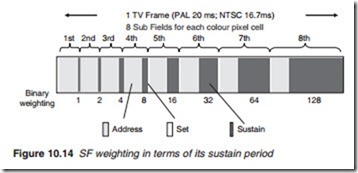Plasma panel brightness
The complete set of SFs has to be processed within the duration of one complete TV picture frame which for the UK’s 625-line system is 20 ms and for the USA’s 525-line system is 16.7 ms. In any SF, the sustain or dis- charge time progressively increases in binary steps. The address period, however, is constant throughout. This is because the address period depends on the number of lines and the duration of the write pulse. Given a typical write pulse of 2 Jls, then for a VGA panel with 480 lines and 8 SF (256 greyscale levels), the address period = 2 Jls X 8 SF X 480 = 7.68 ms.
With a PAL TV field period of 20 ms, the available sustain period per frame = 20 – 7.68 = 12.32 ms. The percentage of the TV field available to sustain the cells = 12.32/20 = 61.6%. The equivalent calculations for NTSC is 17.6 – 7.68 = 9.92 ms giving a percentage sustain of 9.92/17.6 = 56.4%. These are low percentages which result in low panel brightness, something that early plasma panels were notorious for. One of the first methods used to increase the time available for the sustain period is the dual scanning.
Dual scan
With dual scan the screen is divided into two halves: upper and lower. The two halves are initialised and sustained simultaneously, but scanned as two separate screens. Pairs of lines, one from each half are scanned simultaneously thus reducing the time for the address period by almost a half and consequently virtually doubling the time available for the sustain period and with it the maximum brightness of the screen. However, the simultaneous scanning of plasma lines requires two independent panel drive circuits, with the consequent increase in cost.
